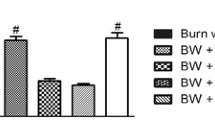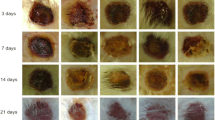Abstract
The present work reports the photo-biomodulatory effect of red (632.8 nm) and near infrared (785 and 830 nm) lasers on burn injury in Swiss albino mice. Animals were induced with a 15-mm full thickness burn injury and irradiated with various fluences (1, 2, 3, 4, and 6 J/cm2) of each laser wavelength under study having a constant fluence rate (8.49 mW/cm2). The size of the injury following treatment was monitored by capturing the wound images at regular time intervals until complete healing. Morphometric assessment indicated that the group treated with 3-J/cm2 fluence of 830 nm had a profound effect on healing as compared to untreated controls and various fluences of other wavelengths under study. Histopathological assessment of wound repair on treatment with an optimum fluence (3 J/cm2) of 830 nm performed on days 2, 6, 12, and 18 post-wounding resulted in enhanced wound repair with migration of fibroblasts, deposition of collagen, and neovascularization as compared to untreated controls. The findings of the present study have clearly demonstrated that a single exposure of 3-J/cm2 fluence at 830-nm enhanced burn wound healing progression in mice, which is equivalent to 5 % povidone iodine treatment (reference standard), applied on a daily basis till complete healing.






Similar content being viewed by others
References
Diegelmann RF, Evans MC (2004) Wound healing: an overview of acute, fibrotic and delayed healing. Frontiers in bioscience : a journal and virtual library 9:283–289
Schreml S, Szeimies RM, Prantl L, Landthaler M, Babilas P (2010) Wound healing in the 21st century. J Am Acad Dermatol 63(5):866–881. doi:10.1016/j.jaad.2009.10.048
Guo S, Dipietro LA (2010) Factors affecting wound healing. J Dent Res 89(3):219–229. doi:10.1177/0022034509359125
Monaco JL, Lawrence WT (2003) Acute wound healing an overview. Clin Plast Surg 30(1):1–12
Velnar T, Bailey T, Smrkolj V (2009) The wound healing process: an overview of the cellular and molecular mechanisms. The Journal of international medical research 37(5):1528–1542
Kao CC, Garner WL (2000) Acute Burns. Plast Reconstr Surg 101(7):2482–2493
Atiyeh BS, Hayek SN, Gunn SW (2005) New technologies for burn wound closure and healing—review of the literature. Burns : journal of the International Society for Burn Injuries 31(8):944–956. doi:10.1016/j.burns.2005.08.023
Fan WPL, Rashid M, Enoch S (2010) Current advances in modern wound healing. Wounds UK 6(3):22–36
Huang YY, Chen AC, Carroll JD, Hamblin MR (2009) Biphasic dose response in low level light therapy. Dose-response : a publication of International Hormesis Society 7(4):358–383. doi:10.2203/dose-response.09-027.Hamblin
Avci P, Gupta A, Sadasivam M, Vecchio D, Pam Z, Pam N, Hamblin MR (2013) Low-level laser (light) therapy (LLLT) in skin: stimulating, healing, restoring. Seminars in cutaneous medicine and surgery 32(1):41–52
Fushimi T, Inui S, Nakajima T, Ogasawara M, Hosokawa K, Itami S (2012) Green light emitting diodes accelerate wound healing: characterization of the effect and its molecular basis in vitro and in vivo. Wound repair and regeneration : official publication of the Wound Healing Society [and] the European Tissue Repair Society 20(2):226–235. doi:10.1111/j.1524-475X.2012.00771.x
Peplow PV, Chung TY, Ryan B, Baxter GD (2011) Laser photobiomodulation of gene expression and release of growth factors and cytokines from cells in culture: a review of human and animal studies. Photomed Laser Surg 29(5):285–304. doi:10.1089/pho.2010.2846
Zhang Y, Song S, Fong CC, Tsang CH, Yang Z, Yang M (2003) cDNA microarray analysis of gene expression profiles in human fibroblast cells irradiated with red light. The Journal of investigative dermatology 120(5):849–857. doi:10.1046/j.1523-1747.2003.12133.x
Demidova-Rice TN, Salomatina EV, Yaroslavsky AN, Herman IM, Hamblin MR (2007) Low-level light stimulates excisional wound healing in mice. Lasers Surg Med 39(9):706–715. doi:10.1002/lsm.20549
Prabhu V, Rao SB, Rao NB, Aithal KB, Kumar P, Mahato KK (2010) Development and evaluation of fiber optic probe-based helium-neon low-level laser therapy system for tissue regeneration—an in vivo experimental study. Photochem Photobiol 86(6):1364–1372. doi:10.1111/j.1751-1097.2010.00791.x
Gupta A, Dai T, Hamblin MR (2014) Effect of red and near-infrared wavelengths on low-level laser (light) therapy-induced healing of partial-thickness dermal abrasion in mice. Lasers Med Sci 29(1):257–265. doi:10.1007/s10103-013-1319-0
Chung H, Dai T, Sharma SK, Huang YY, Carroll JD, Hamblin MR (2012) The nuts and bolts of low-level laser (light) therapy. Ann Biomed Eng 40(2):516–533. doi:10.1007/s10439-011-0454-7
Prabhu V, Rao SB, Chandra S, Kumar P, Rao L, Guddattu V, Satyamoorthy K, Mahato KK (2012) Spectroscopic and histological evaluation of wound healing progression following Low Level Laser Therapy (LLLT). J Biophotonics 5(2):168–184. doi:10.1002/jbio.201100089
Erdle BJ, Brouxhon S, Kaplan M, Vanbuskirk J, Pentland AP (2008) Effects of continuous-wave (670-nm) red light on wound healing. Dermatologic surgery: official publication for American Society for Dermatologic Surgery [et al] 34(3):320–325. doi:10.1111/j.1524-4725.2007.34065.x
Abdullahi A, Amini-Nik S, Jeschke MG (2014) Animal models in burn research. Cellular and molecular life sciences : CMLS 71(17):3241–3255. doi:10.1007/s00018-014-1612-5
Avniel S, Arik Z, Maly A, Sagie A, Basst HB, Yahana MD, Weiss ID, Pal B, Wald O, Ad-El D, Fujii N, Arenzana-Seisdedos F, Jung S, Galun E, Gur E, Peled A (2006) Involvement of the CXCL12/CXCR4 pathway in the recovery of skin following burns. The Journal of investigative dermatology 126(2):468–476. doi:10.1038/sj.jid.5700069
Hadis MA, Zainal SA, Holder MJ, Carroll JD, Cooper PR, Milward MR, Palin WM (2016) The dark art of light measurement: accurate radiometry for low-level light therapy. Lasers Med Sci 31(4):789–809. doi:10.1007/s10103-016-1914-y
Prindeze NJ, Moffatt LT, Shupp JW (2012) Mechanisms of action for light therapy: a review of molecular interactions. Experimental biology and medicine 237(11):1241–1248. doi:10.1258/ebm.2012.012180
Karu T (1999) Primary and secondary mechanisms of action of visible to near-IR radiation on cells. J Photochem Photobiol B Biol 49(1):1–17. doi:10.1016/S1011-1344(98)00219-X
Bayat M, Vasheghani MM, Razavi N (2006) Effect of low-level helium-neon laser therapy on the healing of third-degree burns in rats. J Photochem Photobiol B Biol 83(2):87–93. doi:10.1016/j.jphotobiol.2005.12.009
Bayat M, Vasheghani MM, Razavi N, Taheri S, Rakhshan M (2005) Effect of low-level laser therapy on the healing of second-degree burns in rats: a histological and microbiological study. J Photochem Photobiol B Biol 78(2):171–177. doi:10.1016/j.jphotobiol.2004.08.012
Mun S, Cheon M, Kim SH, Choi N, Kim S, Yoo Y, Lim S (2013) The effect of laser diode irradiation on wound healing of rat skin. Journal of cosmetic and laser therapy : official publication of the European Society for Laser Dermatology 15(6):318–325. doi:10.3109/14764172.2013.807116
Chiarotto GB, Neves LM, Esquisatto MA, Do Amaral ME, Dos Santos GM, Mendonca FA (2014) Effects of laser irradiation (670-nm InGaP and 830-nm GaAlAs) on burn of second-degree in rats. Lasers Med Sci 29(5):1685–1693. doi:10.1007/s10103-014-1573-9
Lee GY, Kim WS (2012) The systemic effect of 830-nm LED phototherapy on the wound healing of burn injuries: A controlled study in mouse and rat models. Journal of cosmetic and laser therapy : official publication of the European Society for Laser Dermatology 14(2):107–110. doi:10.3109/14764172.2011.649762
Hegde VN, Prabhu V, Rao SB, Chandra S, Kumar P, Satyamoorthy K, Mahato KK (2011) Effect of laser dose and treatment schedule on excision wound healing in diabetic mice. Photochem Photobiol 87(6):1433–1441. doi:10.1111/j.1751-1097.2011.00991.x
de Moraes JM, Eterno de Oliveira Mendonca D, Moura VB, Oliveira MA, Afonso CL, Vinaud MC, Bachion MM, de Souza Lino R Jr (2013) Anti-inflammatory effect of low-intensity laser on the healing of third-degree burn wounds in rats. Lasers Med Sci 28(4):1169–1176. doi:10.1007/s10103-012-1213-1
Rezende SB, Ribeiro MS, Nunez SC, Garcia VG, Maldonado EP (2007) Effects of a single near-infrared laser treatment on cutaneous wound healing: biometrical and histological study in rats. J Photochem Photobiol B Biol 87(3):145–153. doi:10.1016/j.jphotobiol.2007.02.005
Gupta A, Keshri GK, Yadav A, Gola S, Chauhan S, Salhan AK, Bala Singh S (2015) Superpulsed (Ga-As, 904 nm) low-level laser therapy (LLLT) attenuates inflammatory response and enhances healing of burn wounds. J Biophotonics 8(6):489–501. doi:10.1002/jbio.201400058
Karu TI, Pyatibrat LV, Kolyakov SF, Afanasyeva NI (2005) Absorption measurements of a cell monolayer relevant to phototherapy: reduction of cytochrome c oxidase under near IR radiation. J Photochem Photobiol B Biol 81(2):98–106. doi:10.1016/j.jphotobiol.2005.07.002
Karu TI, Kolyakov SF (2005) Exact action spectra for cellular responses relevant to phototherapy. Photomed Laser Surg 23(4):355–361. doi:10.1089/pho.2005.23.355
Peng Q, Juzeniene A, Chen J, Svaasand LO, Warloe T, Giercksky K-E, Moan J (2008) Lasers in medicine. Rep Prog Phys 71(5):056701
de Kock M (1985) Topical burn therapy comparing povidone-iodine ointment or cream plus aserbine, and povidone-iodine cream. The Journal of hospital infection 6(Suppl A):127–132
Vermeulen H, Westerbos SJ, Ubbink DT (2010) Benefit and harm of iodine in wound care: a systematic review. The Journal of hospital infection 76(3):191–199. doi:10.1016/j.jhin.2010.04.026
Goldenheim PD (1993) An appraisal of povidone-iodine and wound healing. Postgrad Med J 69(Suppl 3):S97–105
Campbell N, Campbell D (2013) Evaluation of a non-adherent, povidone-iodine dressing in a case series of chronic wounds. J Wound Care 22(8):401–402. doi:10.12968/jowc.2013.22.8.401, 404-406
Daroczy J (2006) Quality control in chronic wound management: the role of local povidone-iodine (Betadine) therapy. Dermatology 212(Suppl 1):82–87. doi:10.1159/000089204
Norman D (2003) The use of povidone-iodine in superficial partial-thickness burns. Br J Nurs 12(6 Suppl):S30–36. doi:10.12968/bjon.2003.12.Sup1.11250
Yuksel EB, Yildirim AM, Bal A, Kuloglu T (2014) The effect of different topical agents (silver sulfadiazine, povidone-iodine, and sodium chloride 0.9%) on burn injuries in rats. Plastic surgery international 2014:907082. doi:10.1155/2014/907082
Dai T, Huang YY, Sharma SK, Hashmi JT, Kurup DB, Hamblin MR (2010) Topical antimicrobials for burn wound infections. Recent patents on anti-infective drug discovery 5(2):124–151
Steen M (1993) Review of the use of povidone-iodine (PVP-I) in the treatment of burns. Postgrad Med J 69(Suppl 3):S84–92
Lane N (2006) Cell biology: power games. Nature 443(7114):901–903. doi:10.1038/443901a
Acknowledgements
The authors would like to thank DAE-BRNS, Govt. of India for funding (Grant no. 2012/34/47). Authors also thank Prof. K. Satyamoorthy, Director, School of Life Sciences (SLS) for his support and Manipal University for providing necessary facilities at School of Life Sciences, Manipal University to conduct the study. We extend our gratitude to Dr. Vasudevan T. G, Associate Professor, SLS for his support in scientifically editing the manuscript. Our thanks are also due to Mr. Sudhakar Kotian and Mr. Dheeraj for their help in animal handling and care.
Author information
Authors and Affiliations
Corresponding author
Rights and permissions
About this article
Cite this article
Rathnakar, B., Rao, B.S.S., Prabhu, V. et al. Photo-biomodulatory response of low-power laser irradiation on burn tissue repair in mice. Lasers Med Sci 31, 1741–1750 (2016). https://doi.org/10.1007/s10103-016-2044-2
Received:
Accepted:
Published:
Issue Date:
DOI: https://doi.org/10.1007/s10103-016-2044-2




